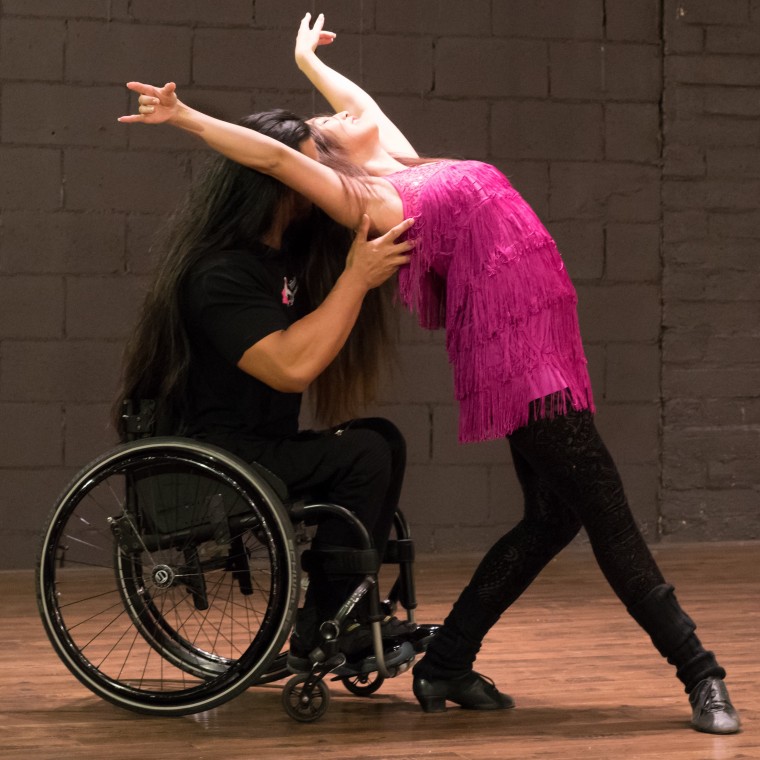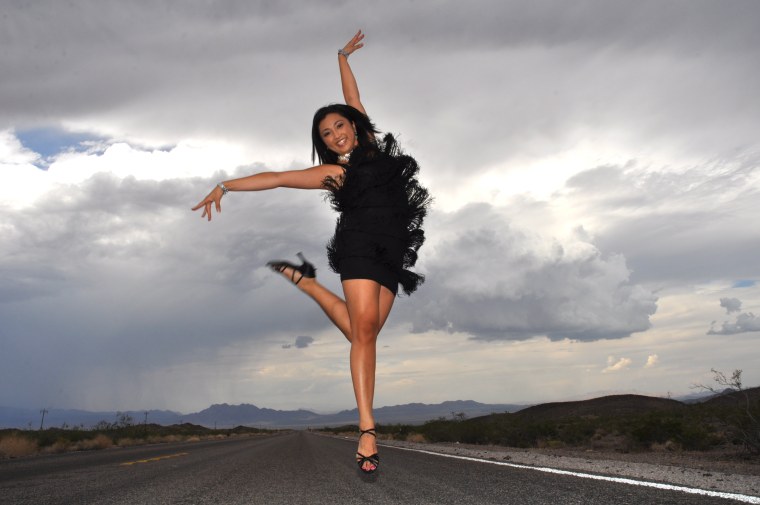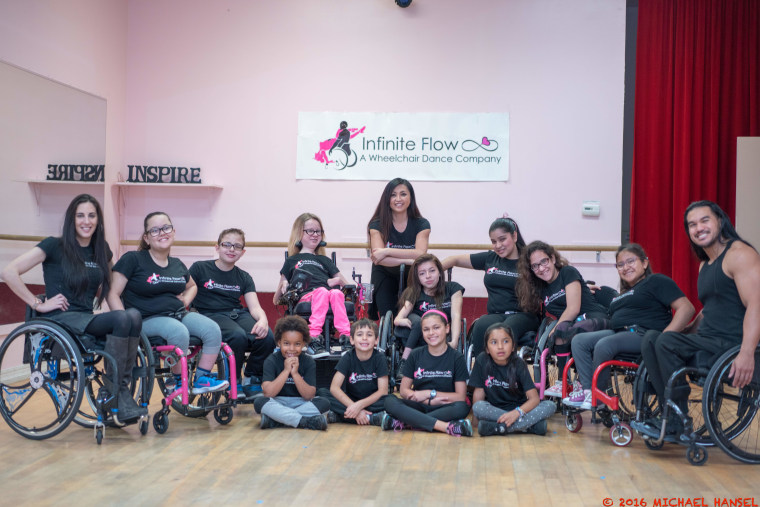Marisa Hamamoto moved swiftly across the dance floor as she practiced a series of high-energy jumps and acrobatic movements during a contemporary dance class in Tokyo in 2006.
But within minutes, her life as a dancer was put on hold when she was hit by a chilling numbness that took over her body. One moment, she felt as though she were flying, and the next, she found herself losing all sensation.
“In the middle of all of that, I started to feel my elbows tingle and then a couple minutes later, I collapsed onto the floor,” Hamamoto told NBC News. “I couldn’t move my arms and legs.”
Hamamoto, then 24 and a senior at Keio University, was rushed to the hospital and later diagnosed with a spinal cord infarction — a stroke in the spinal cord or an artery that supplies it — which left her paralyzed from the neck down. Doctors told her she would probably never walk or dance again.
During her physical therapy and rehabilitation, Hamamoto incorporated her own dance training into her recovery instead of sticking to a sheet of plain exercises that were given to her, she said.
“Instead of lifting my knees, I would hum a song and lift it into a rhythm,” Hamamoto said. “Every single tiny movement I would feel, I would try to dance. I literally danced my therapy and made it into my own dance class.”
“Being the only Asian-American kid in class, I was also teased for being a little chubby so somehow the dancing...when I danced, I almost felt like I can forget all of that,”
Two months later, Hamamoto walked out of the hospital, ready to perform again, but after her paralysis, she suffered from post-traumatic stress disorder, she said, and any time she felt a tingle in her body, she’d have reoccurring nightmares and immense anxiety.
“I lived in a lot of trauma,” she said.
After the paralysis, Hamamoto feared going to a dance studio. She had faced her share of rejection as a dancer for many years, and the paralysis felt like another door that had closed on her.
“The more my body moved, the more I became scared that the paralysis was going to happen again,” Hamamoto said.
RELATED: 'Dances Of Transformation': Ananya Dance Theatre Finds Justice Through Movement
Raised in Irvine, California, Hamamoto was first exposed to dance at the age of six. Growing up, Hamamoto couldn’t help but feel different. She recalls one day in elementary school when she brought sushi and rice to school, only to be teased by her fellow classmates for her lunch choices and the shape of her eyes.
“Being the only Asian-American kid in class, I was also teased for being a little chubby so somehow the dancing...when I danced, I almost felt like I can forget all of that,” She said. “Whenever I danced, I felt beautiful. I felt free. I felt powerful.”
At age 12, Hamamoto — whose father is from Honolulu and mother is from Japan — had her heart set on becoming a professional ballerina after being inspired by a ballet performance at the Segerstrom Center for the Arts. She shoved the criticisms aside and forged her own path.
“Everything about that performance — from the dancers, to the stage set, to the costumes, to just the whole being on stage under the lights — everything about it, I just fell in love and wanted to be up there myself,” she said.
But not everyone was supportive of her decision to become a professional ballerina.
“Even though I worked really hard, and got scholarships to top ballet schools, I was still being told by my dance teachers I didn’t have what it took to be a ballerina,” she said.
“Even though I worked really hard, and got scholarships to top ballet schools, I was still being told by my dance teachers I didn’t have what it took to be a ballerina.”
But those criticisms and doubts only fueled Hamamoto’s dreams of becoming a professional dancer. Three and a half years after her paralysis, dance found its way back into Hamamoto’s life. In 2010, she attended a New Year’s party in Japan, where she was first exposed to partner dancing and noticed the transformative effect it had on dancers and non-dancers alike.
“Everything I ever wanted in dancing was in a ballroom — something about connecting with another partner was something beautiful,” she said.
Several months later, Hamamoto received an apprenticeship at one of the best ballroom dance schools in Japan, she said.
She moved back to California in 2011, and in 2012 made her way to Los Angeles, where she was determined to grow as a professional dancer and share her love for ballroom with others. Two years later, Hamamoto discovered wheelchair ballroom dancing, which she found was underdeveloped. She felt compelled to take action and enhance it, in part due to her own paralysis, she said.

“I saw that there was an underserved population with people with disabilities and especially paralyzed from the waist down, neck down, that didn’t have opportunity to go to dance class,” she said. “Because I’ve had so many doors close on me as a dancer, I decided to open it up for others.”
Determined to create a more inclusive and diverse space, Hamamoto launched Infinite Flow — a professional wheelchair dance company with studios in Studio City and Sherman Oaks, California that aims to change perceptions on disability and show what inclusion in dance and everyday life can look like — in 2015.
“I truly believe that every single person has a dancer inside of them and each person deserves to find that dancer,” she said. “I think we can create a better world through accepting and celebrating each other’s differences.”
RELATED: On Stage and With Pageants, Jennifer Kumiyama Is Improving Life for People With Disabilities
Hamamoto said Infinite Flow is the first professional wheelchair ballroom dance company in the nation, though she notes the existence of other physically integrated dance companies that focus more on contemporary dance.
“Infinite Flow is not about wheelchair users, it’s about everyone,” she said.
Infinite Flow incorporates six main programs, including a professional dance troupe created to change society’s perceptions on disability. Other programs include “Infinite Flow Kids” and adult wheelchair dance classes. Hamamoto has also spearheaded a new project called Infinite Inclusion, which centers on community events that celebrate diversity and dance.
Hamamoto said she has received calls from people around the world who have shared concerns about the lack of inclusive dance classes in their local communities. She recalled the story of a mother who struggled to find a dance studio that would enroll her daughter, who was in a wheelchair.

“The mother wanted her [daughter] to be in a group class, but no one would take her seriously,” she said.
While Infinite Flow is still in its beginning stages, Hamamoto acknowledges the stigma that still exists within the dance community and beyond.
“People don’t take the work seriously,” she said.”I still run across the same issue in my community. I think people still look down on what we do.”
Hamamoto said that ballroom dancing healed her at a time when she had lost all hope. She equally hopes that Infinite Flow will help others dance their way through life’s obstacles, too.
“For me, so many doors had closed up on me as a dancer and I still feel like I’m trying to find the dancer inside of me,” she said. “I feel like it is almost like my mission to help open doors for others. I’m seeing barriers being broken in front of my face all the time.”
